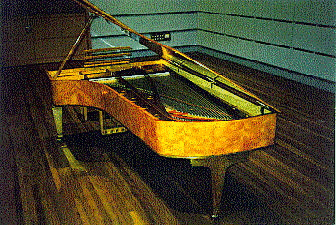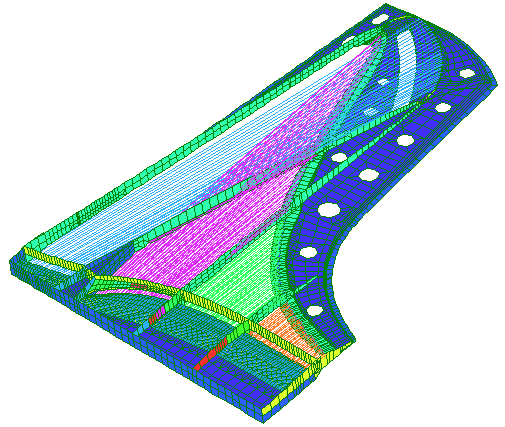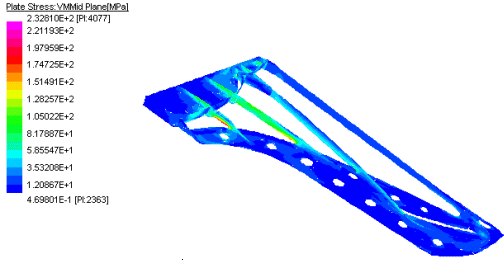Strand7 Software: Case Studies: Grand Piano
A design analysis of a Stuart and Sons grand piano frame |
| D. Clausen, B. Hughes and W. Stuart Department of Mechanical Engineering Faculty of Music The University of Newcastle University Drive, Callaghan, NSW 2308, AUSTRALIA |
Abstract |
| This article describes a design analysis of the frame from a Stuart and
Sons grand piano, the world's newest manufacturer of concert grand pianos. The
frame, strings and hitch pins were accurately modelled using finite element
analysis. String tensions were applied to all 258 strings and the model solved.
The results of the analysis show the frame was reasonably structurally
efficient. Modifications to the size of various sections within the frame
resulted in a reduction of the frame's mass by about 7 kg while simultaneously
increasing its overall strength. |
 |
|
| The three hundred year history of the acoustic piano reflects a myriad of intellectual, social and technological achievements. The piano makers of the 19th century were so successful in applying their scientific and engineering knowledge to the evolution of the instrument they inherited from the previous century, that many people today believe the design of the acoustic piano has reached perfection. This belief, unfortunately, is fallacious ignoring the significant gains in scientific and engineering knowledge during the 20th century. The general acceptance of this belief, however, has resulted in a standardisation of the piano form with its musical reproduction unchallenged. This is the legacy of the 20th century piano maker. |
Wayne Stuart, the designer and maker of the world's newest concert grand piano, is motivated by the notion that there is life beyond Steinway! He has spent half a lifetime studying, researching and ultimately designing and building a concert grand to prove this point. After a recital on a Stuart and Sons grand piano at the Conservatorium Concert Hall, The University of Newcastle, the great pianist Michele Campanella wrote: "With great pleasure and interest, I experienced the new sound of the Stuart and Sons piano. I am pleased that in Australia there is such a vision for the future". |
The Stuart and Sons piano is about a new direction for an instrument with a long tradition of slow adaptation to innovation and change. The challenge is to build a new concert grand piano by taking traditional musical qualities and combining them with contemporary technology and skills to produce a musical instrument capable of reaching into the psyche of the future. |
To date Stuart's focus has been on coupling the strings to the bridge/soundboard and the knife edges that terminate the portion of the string that determines its frequency. In collaboration with colleagues from the Department of Mechanical Engineering at his university, Stuart has developed a sophisticated bridge agraffe designed to retain the vertical mode of vibration produced when the hammer strikes the string. Compared to the standard piano, these new instruments demonstrate a dramatic improvement in tuning and internal damping of the string's decay transients. |
Stuart felt the weight of his grand piano frame was excessive. Lowering the weight of the cast iron frame could only be achieved by a reduction in the size of the various sections within the frame. This task could not be done intuitively given the complex geometry of the frame and the need to ensure that the static and dynamic integrity of the frame was maintained. So a Strand7 finite element analysis was used to model the existing frame and to evaluate the effects of any structural change to its overall performance. Finite element analysis is widely used in industry but, given the dearth of any published literature, it appears to be seldom used or not used at all to assist in the design of high quality piano frames. One of the purposes of this article is to show that these computational tools are extremely useful to the piano designers and possibly other musical instrument designers. Before discussing this work, however, it is pertinent to discuss the underlying rationale in the piano frame's design. |
|
| The piano's frame, the massive supporting structure underlying the instrument's acoustic and structural viability, must not only be able to support over 230 kN of string tensions but must possess certain properties that can appear conflicting. For example, the frame must be rigid but retain certain flexibility; it must have sufficient mass to assist the low frequencies but not to adversely affect the high frequencies; it should be constructed from a material with a low coefficient of thermal expansion to minimise changes in string tension and hence vibration frequency; be relatively straightforward to manufacture, usually by a casting process; be aesthetically pleasing, as it is usually in the view of the audience; shaped so that parts and components of the piano's playing mechanism can be accommodated, and be designed so that any bar resonances will not interfere with the instrument's frequency range. Furthermore it is desirable for the piano frame to have the lowest mass possible wi thout detracting from its musical intent. |
|
| The detailed finite element model of the existing Stuart and Sons piano
frame was built and solved using Strand7. The complex geometry of the piano's
cast iron frame was modelled using over 5000 "thin shell" plate
elements. The various colours of these elements in the model designate sections
of different thickness. Regions of rapidly changing shape and thickness and
where the stress gradients are likely to be high, are modelled with many small
elements to capture accurately the structure's performance. The strings of the
piano and the hitch pins were modelled using "beam" elements, an
element used typically to model long and slender members which usually have
constant, compact cross-sections. String tensions were applied by using a
thermal technique which axially shrinks the constrained string elements and in
so doing tensions it. The model of the frame was held to simulate as closely as
possible its connections within the piano. It was found that the mass and centre of mass of the model were very close to those of the actual frame giving a
great deal of confidence in the geometric accuracy of the model. |
 |
| Contours of von Mises stress for the frame under the action of string
tensions only are shown in the figure below. These results show that most of the
frame is lightly stressed except for the lower section of the three stiffener
bars which bridge the sound board region of the frame. As expected the maximum
stresses were below the yield values for the frame's material, grey cast iron.
Additional analysis was undertaken to predict the load at which members within
the frame would collapse by buckling. It was found that the longest of the
stiffener bars would be the first to buckle if the string tensions were
increased by about 25%. Further, the predicted resonant frequencies of the
frame were found to be close to some of the string's vibrational frequencies.
This however was found not to cause sympathetic resonance in the frame possibly
indicating that the available vibrational energy was insufficient to excite the
frame. Overall, the analyses showed the frame was a reasonably efficient struct
ure. Nevertheless a redesign of the frame was considered pertinent given the
uneven stress distribution within the structure. |
 |
| The physical constraints imposed on the design of the piano frame essentially eliminate significant changes to its physical form. Most of the changes involve altering the size of various sections within the frame with the lower stressed sections undergoing a reduction in size and some of the higher stressed members, principally the stiffeners, increasing in size. Furthermore any modification to the frame could not lower its buckling strength as well as significantly altering its resonant frequencies. The final modifications to the frame reduced its mass by about 7 kg while simultaneously increasing its overall strength. The frame now is structurally more efficient. |
|
| The work described in this article shows that sophisticated computational engineering design tools can be readily used to improve the structural performance of piano frames and most likely any other musical instrument. This task is not straightforward as most engineers are not verse with the fine and subtle features which divide an instrument of high quality from that of pedestrian quality. Conversely piano designers and makers do not generally understand basic engineering principles which underpin the success of the structural design of any instrument. At The University of Newcastle, Australia a successful collaboration between a world class piano designer and maker and skilled engineers has resulted in a structurally more efficient design of a cast iron grand piano frame. The work, however, does not finish here. |
The easiest way to reduce the weight of the frame is by manufacturing it from a strong lightweight material. Investigations to date suggest carbon-fibre reinforced composite is a suitable material which could reduce the frame's weight by up to 75%. Whilst it is relatively easy to design and build a strong, structurally efficient frame using carbon-fibre, it may prove much more difficult to ensure the frame has highly desirable musical qualities. The latter design constraint may prove to be a major challenge. |

 Menu
Menu